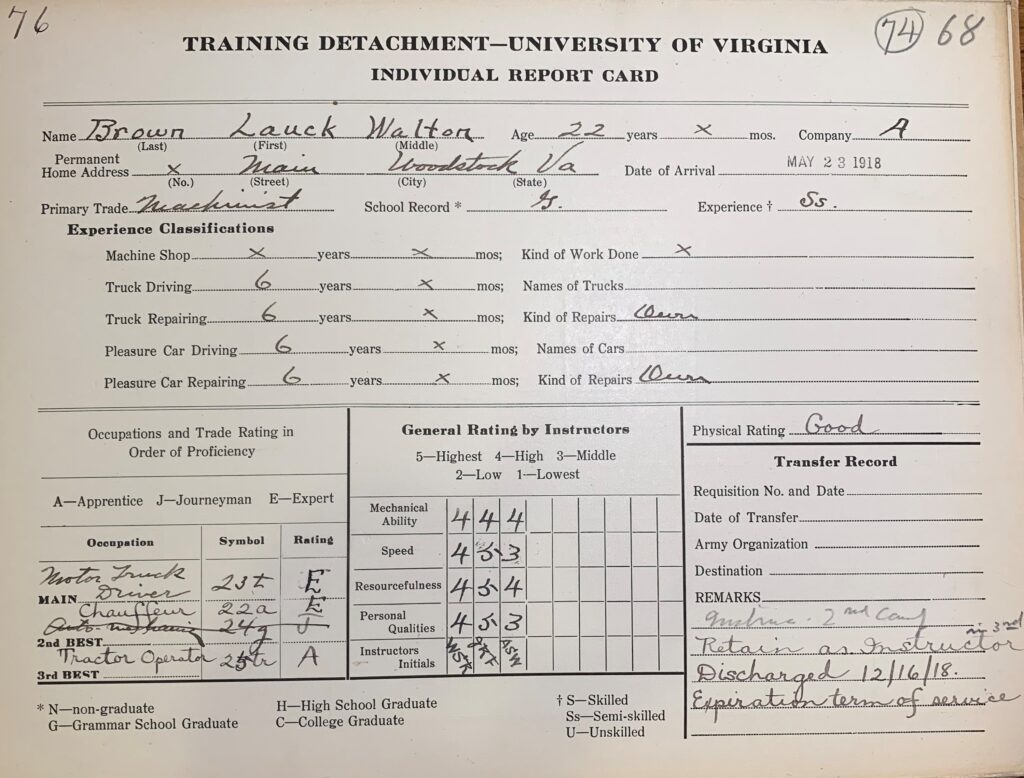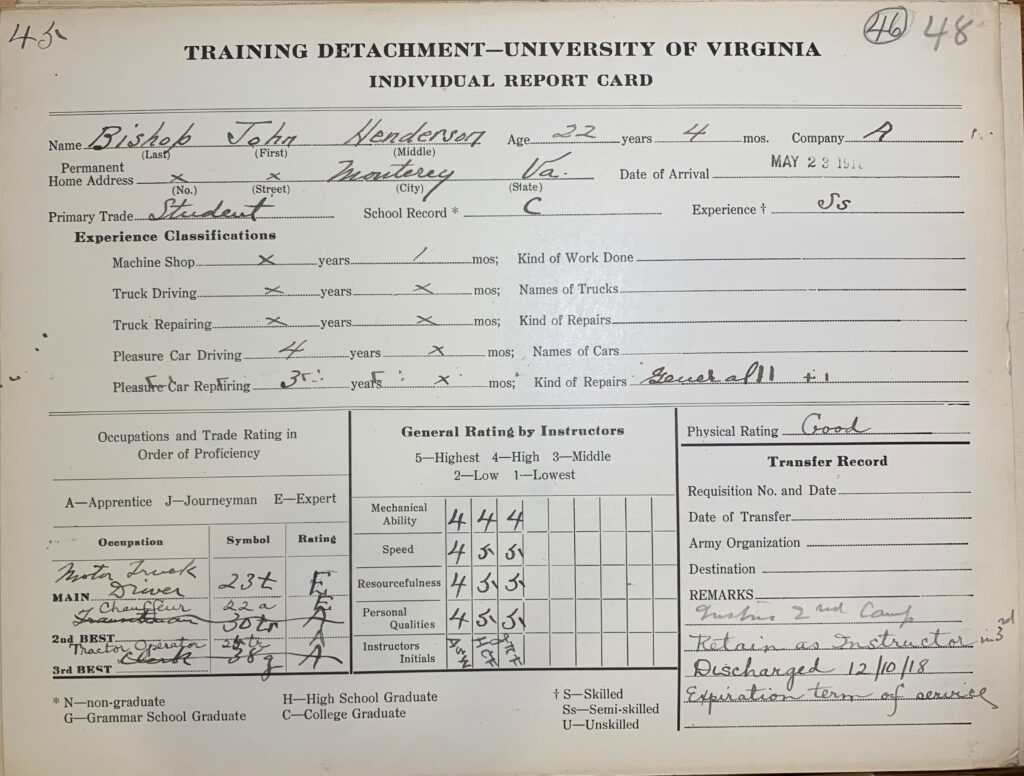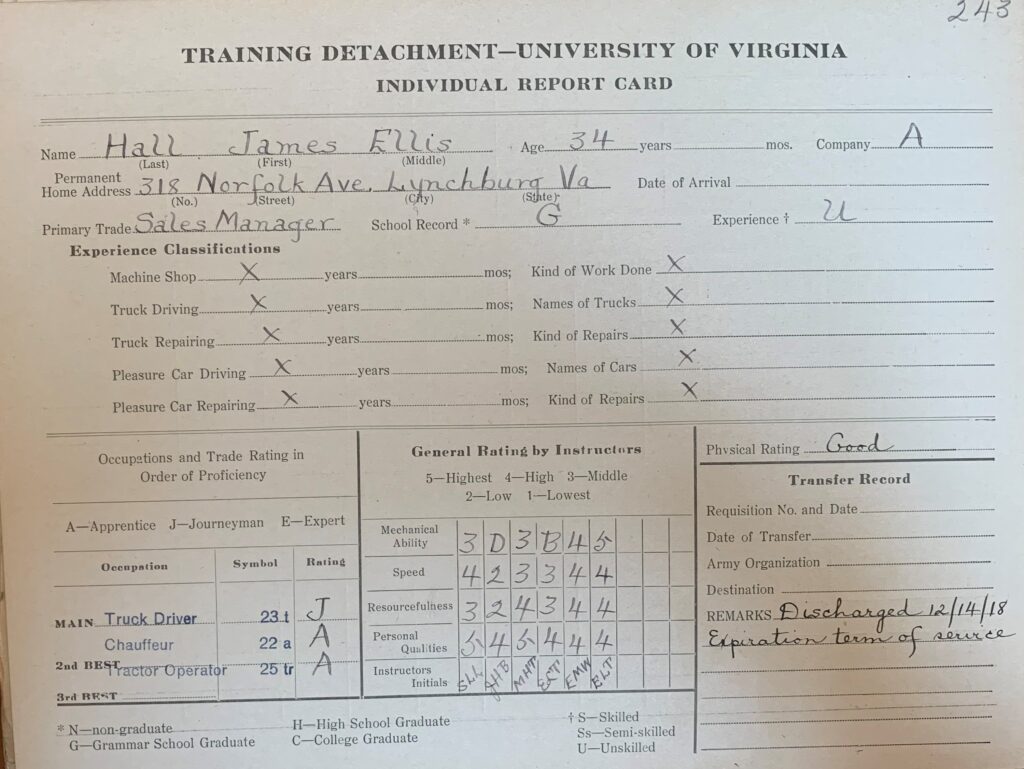The University of Virginia (UVA) had a National Training Detachment (NTD) which became the vocational training B Section of their SATC unit in October 1918. The UVA NTD focused on learning skills related to automobile maintenance, care, and operation and it is likely that the SATC B Section continued this training. The UVA Special Collections only has records for the NTD, but given the similarities between the two programs and the success of the NTD, it is safe to assume that the training and evaluation for the SATC was the same as the NTD.
Evaluation & Job Placement
Men in vocational sections were tested and graded in two areas: shop work and driving. For shop work, soldiers were evaluated on their knowledge of engine maintenance, with particular attention to ignition systems, valves, cooling, and overall mechanical details. In addition, they were expected to be familiar with performing maintenance on the vehicle frame, axles, wheels, clutch, transmission, and gears. For the driving portion, men were evaluated on their driving skills and control of the vehicle as well as their ability to trouble shoot mechanical problems. Vocational soldiers were also rated by their instructors in mechanical ability, speed, resourcefulness, and personal qualities.1

Once the men had completed their training, instructors would list the three best roles for each man based on proficiency levels. The most common roles were chauffeur, truck driver, tractor operator.2 Men were rated either as Apprentice, Journeyman, or Expert based on their skill level, with expert being the highest. Chauffeurs were responsible for driving officers and other important persons, trucks were used to move men and material, and tractors were utilized to move equipment.
American Tractors in World War I
The Holt Caterpillar Company, the precursor to Caterpillar, sold tractors to France and Britain during the war and they were used to haul heavy equipment. When the United States joined the war, Holt received a government contract to “build as many tractors as the company could.”3
Mechanics: Young & Old
Unlike the collegiate section of the SATC, which had strict education and age requirements, the vocational section did not discriminate based on age, education, or experience. A majority of the men were between the ages of eighteen and twenty-two, but many men in their late twenties through mid-thirties also joined. The report cards of NTD men from the UVA unit show the variety of men who were a part of the NTD and the B Section of the SATC.
Lauck Walton Brown
Lauck Walton Brown was twenty-two years old when he entered UVA’s NTD program in May 1918. Brown came from Woodstock, VA, a town between Harrisonburg and Winchester. While he only had a grammar school education, he worked as a machinist by trade and had six years of experience working in a machine shop, six years experience driving and repairing trucks, and six years experience driving and repairing cars. His instructors rated him an expert truck driver and chauffeur and an apprentice tractor operator. His file notes that he should be retained as an instructor, though it is unclear if he became an instructor.5

John Henderson Bishop
John Henderson Bishop was a twenty-two year old student when he joined UVA’s NTD in May 1918. Hailing from Monetery, VA, a small town northwest of Staunton near the West Virginia border, Bishop was a college graduate. Unlike Lauck Walton Brown, Bishop did not have much mechanic experience, only three years of working on a personal car. But like Brown, Bishop excelled in his training. He was rated an expert truck driver, an expert chauffeur, and an apprentice tractor operator by his instructors. His file also notes that he should be retained by the unit as an instructor.7

James Ellis Hall
James Ellis Hall joined UVA’s vocational training unit with no mechanical experience or driving experience. He only had a grammar school education, worked as a sales manager in Lynchburg, VA, and was 34 years old, significantly older than a majority of the unit. Hall was rated by his instructors as a journeyman truck driver, apprentice chauffeur, and an apprentice tractor operator.9

Notes:
- Students’ Army Training Corps (University of Virginia), Records, 1917-1918, Accession #38-627, Special Collections Dept., University of Virginia Library, Charlottesville, VA.
- Students’ Army Training Corps (University of Virginia), Records, 1917-1918, Accession #38-627, Special Collections Dept., University of Virginia Library, Charlottesville, VA.
- “Caterpillar | Caterpillar and World War I,” Caterpillar, accessed March 4, 2023, https://www.caterpillar.com/en/company/history/archive/caterpillarandworldwari.html.
- Field Test at Holt Manufacturing Plant c. 1917 | Caterpillar and World War I, 2017, https://www.youtube.com/watch?v=FpPUzc-IIB8.
- Lauck Walton Brown Report Card, Students’ Army Training Corps (University of Virginia), Records, 1917-1918, Accession #38-627, Special Collections Dept., University of Virginia Library, Charlottesville, VA.
- Lauck Walton Brown Report Card, Students’ Army Training Corps (University of Virginia), Records, 1917-1918, Accession #38-627, Special Collections Dept., University of Virginia Library, Charlottesville, VA.
- John Henderson Bishop Report Card, Students’ Army Training Corps (University of Virginia), Records, 1917-1918, Accession #38-627, Special Collections Dept., University of Virginia Library, Charlottesville, VA.
- John Henderson Bishop Report Card, Students’ Army Training Corps (University of Virginia), Records, 1917-1918, Accession #38-627, Special Collections Dept., University of Virginia Library, Charlottesville, VA.
- James Ellis Hall Report Card, Students’ Army Training Corps (University of Virginia), Records, 1917-1918, Accession #38-627, Special Collections Dept., University of Virginia Library, Charlottesville, VA.
- James Ellis Hall Report Card, Students’ Army Training Corps (University of Virginia), Records, 1917-1918, Accession #38-627, Special Collections Dept., University of Virginia Library, Charlottesville, VA.